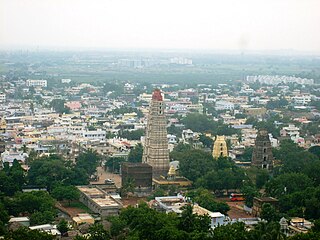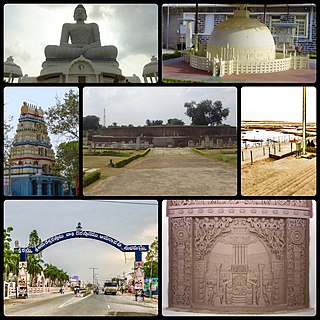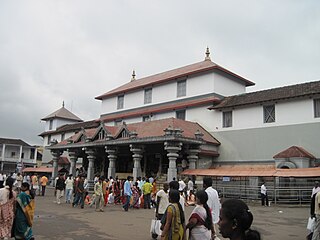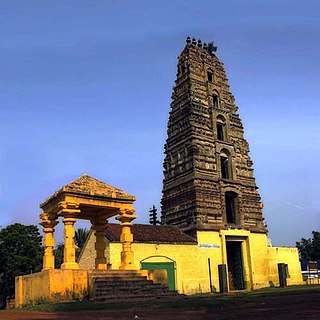
Mangalagiri is a major Sub-urban of Vijayawada in Guntur district of Indian state of Andhra Pradesh. The town is a part of Mangalagiri Tadepalli Municipal Corporation and part of Tenali revenue division. It and a part of Andhra Pradesh Capital Region. It is situated on National Highway 16 between Vijayawada and Guntur.

Amaravathi is a village on the banks of the Krishna River, in the Palnadu district of the Indian state of Andhra Pradesh. It is the headquarters of Amaravathi mandal, and forms part of the Andhra Pradesh Capital Region with its headquarters at new Amaravati 35 km (22 mi) east, whose name is also borrowed from that of the older Amaravathi.

Dharmasthala is an Indian temple town on the banks of the Nethravathi River in the Belthangady taluk of the Dakshina Kannada district in Karnataka, India.

Guntur district is one of the twenty six districts in the Coastal Andhra region of the Indian state of Andhra Pradesh. The administrative seat of the district is located at Guntur, the largest city of the district in terms of area and with a population of 670,073. It has a coastline of approximately 100 km (62 mi) on the right bank of Krishna River, that separates it from Krishna district and NTR district. It is bounded on the south by Bapatla district and on the west by Palnadu district. It has an area of 2,443 km2 (943 sq mi) and with a population of 20,91,075 as per 2011 census of India.

The Pancharama Kshetras or the Pancharamas are five ancient Hindu temples dedicated to the deity Shiva in Andhra Pradesh. According to regional legend, the lingams at these temples are made from a single lingam.

Draksharamam is one of the five Pancharama Kshetras that are sacred to the Hindu god Siva. The temple is located in Draksharamam town of Konaseema district in the Indian state of Andhra Pradesh. Bhimeswara Swamy refers to Lord Siva in this temple.

Somarama is one of the five Pancharama Kshetras that are sacred to the Hindu god Shiva. The temple is located in Bhimavaram of West Godavari district in the Indian state of Andhra Pradesh. It is one of the centrally protected monuments of national importance.

Ksheerarama is one of the five Pancharama Kshetras that are sacred to the Hindu god Shiva. The temple is located in Palakollu of West Godavari in the Indian state of Andhra Pradesh. Shiva is known locally as Ksheera Ramalingeswara Swamy. It is believed that staying one day in Kshirarama is equivalent to staying one year in Varanasi. It is one of the centrally protected monuments of national importance.

Kumararama or Bhimarama is one of the five Pancharama Kshetras that are sacred to the Hindu god Shiva. The temple is located in Samalkota of Kakinada district in the Indian state of Andhra Pradesh. The other four temples are Amararama at Amaravati(Dist. Guntur), Draksharama at Draksharama, Ksheerarama at Palakollu and Somarama at Bhimavaram(both in Dist. West Godavari). It is one of the centrally protected monuments of national importance.

Vasireddy Venkatadri Nayudu was a hereditary zamindar of Chintapalli, later Amaravathi, in the Palnadu district of India, under the British East India Company. He had under his control 552 villages and towns located in Guntur and Krishna districts and their environs. Peeved by the perceived mistreatment by the East India Company, he abandoned his hereditary palace at Chintapalli and built a new palace and town at Amaravathi, the site of the ancient Satavahana capital. In the process of its construction, his workers unearthed the famous Amaravati Stupa as well as causing considerable damage to it.

Chebrolu is a village in Guntur district of the Indian state of Andhra Pradesh. It is the headquarters of Chebrolu mandal in Tenali revenue division. It was once a Buddhist site and territorial capital of Kakatiya dynasty. The Archaeological excavations revealed Buddhist artefacts of Satavahana and Ikshavaku period.

Kotipalli also known as Koti Theertham is a village located in K. Gangavaram mandal of Ramachandrapuram revenue division in Konaseema district of Andhra Pradesh, India. The temple town is also known as Kumararama of the Pancharama Kshetras, and is located 15 km from Amalapuram. Every year festivals such as Maha Sivaratri, Vaisakha Suddha Ekadasi, Aswayuja Suddha Padyami to Dwadasi and Ksheerabdi Dwadasi Teppotsavam are celebrated in this village.
Mandarthi is a place located 12 km from Brahmavar in the Brahmavara taluk of Udupi District in Karnataka state, India. The name derives from 'Manda-Aarathi' from Kannada, meaning the holy light.
Anantavaram is a neighbourhood and a part of Urban Notified Area of Amaravati, the state capital of the Indian state of Andhra Pradesh. It was a village in Thullur mandal of Guntur district, prior to its denotification as gram panchayat.

Sri Revanna Siddeshwara Swamy Temple is a Hindu pilgrimage centre situated in Karnataka State in India. It is located in Avverahalli village of Ramanagara taluk.

Amaravati is the capital of the Indian state of Andhra Pradesh. It is located on the right bank of the river Krishna in Guntur district.

Pushpagiri Temple Complex is a temple complex located in Kadapa district in Andhra Pradesh, India. Founded around 7th Century CE, it houses some of the oldest temple congregations in the region.

Lakshmi Narasimha Temple is a Vaishnavite temple and one of the eight sacred places of Lord Vishnu in India. It is also known for being one of the eight mahakshetras Narasimha in India. It is situated at the foot of the Auspicious Hill in Mangalagiri which is part of the Mangalagiri Tadepalle Municipal Corporation part of Guntur district of Andhra Pradesh, India. It is one of the temples in the series of three temples located on and at the bottom of the hill, the other two being Panakala Narasimha Temple on the hill and Gandala Narasimha Temple at the top of the hill. It has one of the highest gopurams in South India and only one of its type in this part of India. It is 153 feet (47 m) in height and 49 feet (15 m) wide and has eleven storeys.
Veerabhadra Temple is located on Devakuta Parvatham, a hillock on an islet amidst the Godavari River near Pattiseema in West Godavari, Andhra Pradesh. The temple is dedicated to Shiva and the namesake is Veerabhadra.

Bugga Ramalingeswara Swamy temple is a Siva shrine situated on the southern bank of the Penna river in Tadipatri, Anantapur district of Andhra Pradesh, India. It was built between 1490 and 1509 by Pemmasani Ramalinga Nayudu I, a chieftain of the Gutti-Gandikota region during the reign of the Vijayanagara Empire.

























